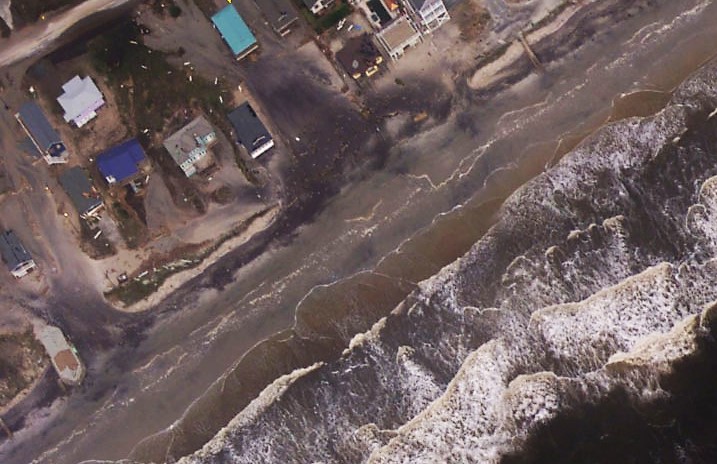
TOPSAIL BEACH – A Winston-Salem-based nonprofit granted $5 million in state funds aims to complete what could turn out to be several long-term, storm-mitigation projects along Topsail Island.
Resource Institute, or RI, which received the multi-million-dollar Division of Water Resources grant last year, will spearhead a yet-to-be formed committee that will prioritize a list of proposed projects in the three towns on the island.
Supporter Spotlight
The list of 23 proposed projects the towns submitted to RI totals an estimated $40 million and covers everything from stormwater mitigation to beach access ramps for vehicles, pumping systems for flood waters and sea oat planting to stabilize dunes, according to institute officials who provided the information.
“Projects that addressed water quality. Projects that addressed your drainage issues,” said Michael R. “Squeak” Smith, RI’s board chairman.

Projects proposed by North Topsail Beach, Surf City and Topsail Beach range in estimated costs from $15,000 to $15 million.
Smith and Charles Anderson, RI’s consulting agent, met last week with the Topsail Island Shoreline Protection Commission, or TISPC, in Topsail Beach to explain the role of the committee.
The task force, chaired by either Smith or Anderson, will consist of representatives appointed by each town (one person per town), two sitting RI board members — Dick Barber of Washington, North Carolina, and Roy Pender of Southport — and North Carolina Coastal Federation Executive Director Todd Miller. RI has asked town officials to submit the names of prospective task force members by Feb. 15.
Supporter Spotlight
The committee will review and rank each project, then those projects selected by the committee will be sent to Raleigh for approval.

“We’re going to come up with a vetting format to rank the projects,” Smith said. “Everybody gets one vote. Each project will have a number and, at the end of the day, each project will be ranked.”
The concept, he said, is that the $5 million will be allocated to projects that will help the towns recover more quickly after hurricanes.
When RI initially received the grant last summer, the nonprofit was instructed to use the money to work with coastal local governments and engineering firms “to explore opportunities for the development and implementation of emerging techniques that can extend the useful life of beach nourishment projects,” according to state budget language.
“Do something that’s going to be much longer term than pumping sand down the beach,” Smith said.
After Hurricane Florence hammered the North Carolina coast in mid-September of last year and beach towns suffered the remnants of Hurricane Michael later that same month, state lawmakers decided to change the wording, honing in on Topsail Island.
Storm surge pummeled the island’s dunes, stripped the beaches of tons of sand, leveled shoreline berms and damaged a multitude of homes and businesses. Both North Topsail Beach and Surf City are currently operating out of temporary town halls.
Resource Institute has done some work on coastal projects, including at the historic Brunswick Town/Fort Anderson site, where the largest state permitted living shoreline project is underway on the banks of the Cape Fear River in Brunswick County.
A majority of the institute’s work has historically dealt in inland stream- and wetlands-restoration projects.
Questions and rumors circulated as to why this particular nonprofit – based more than 200 miles west of the coast – was granted the funding to work on coastal storm mitigation projects.
Anderson explained in an interview before the TISPC’s Jan. 24 meeting that the nonprofit recognized a need along the coast.
“It came down to the coast needs a lot more help right now,” he said. “We are a project-driven organization nonprofit. If it can’t be a tangible item that we can see we prefer not to be involved.”
RI works with other nonprofits, local governments and private entities to aid in the planning, design, and engineering of projects. It also helps find funding sources for those projects.

Smith said he believes there will be more opportunities to get additional funding for hurricane recovery, money that could be put toward the projects that make the cut.
“We’re here for the long haul to get this stuff done and I look at this initial $5 million as a starting point,” he said to the commission last week.
Miller, who is to be a voting member on the committee, had not seen the project list, but he said the grant amount would be a big investment for stormwater retrofit and living shoreline projects.
“Those would be pretty significant because those things are widespread,” he said. “I welcome the opportunity to speak with the town officials about stormwater opportunities and living shoreline opportunities. Most of those can be done fairly quickly.”
RI has sent a draft agreement to the state with plans to form the project-selection committee within the coming weeks.
Anderson said the goal is to get projects on the ground within a year of approval.
“Our objective is to speed this thing along, make it happen,” he said. “We want to spend this money within 12 months.”







